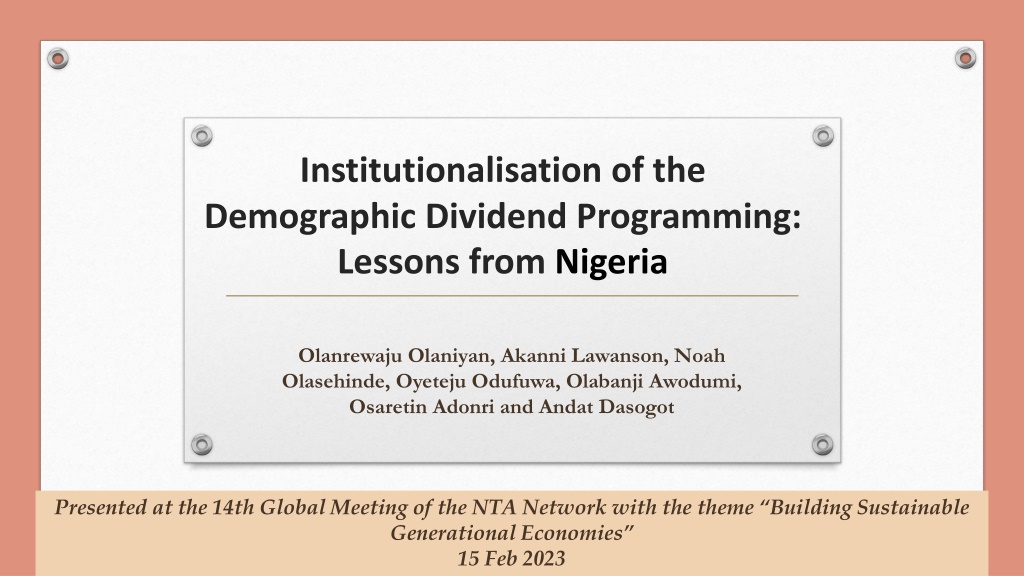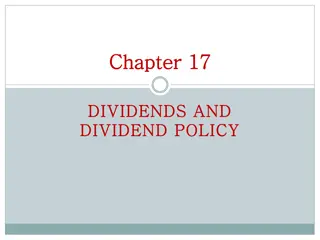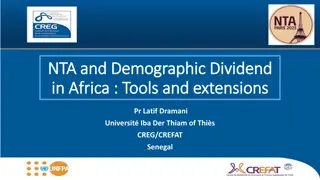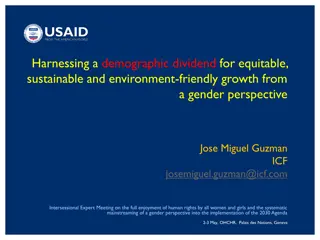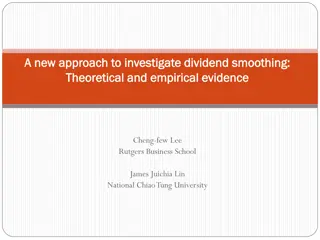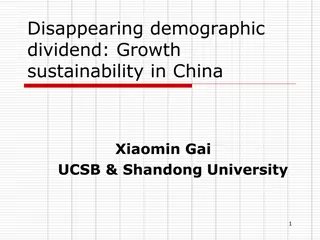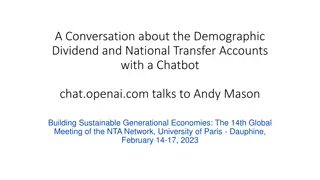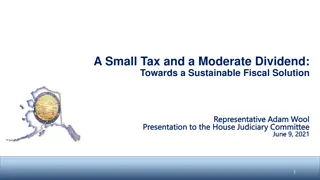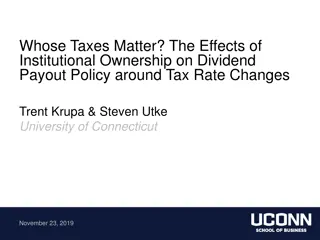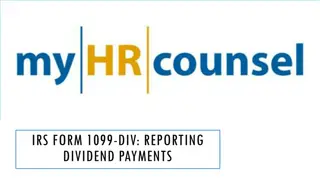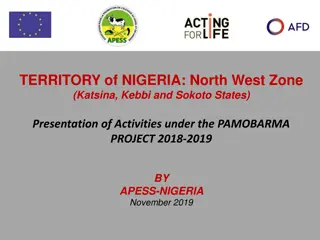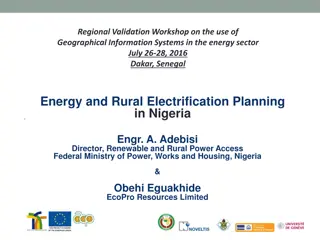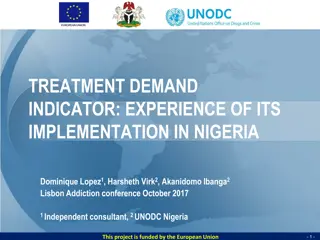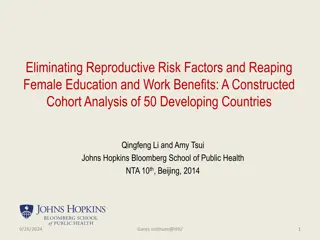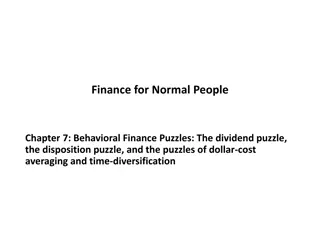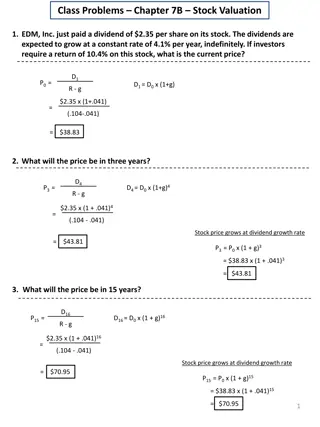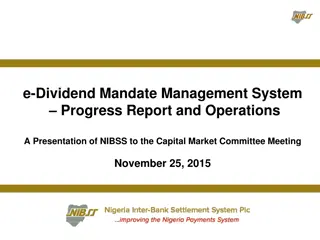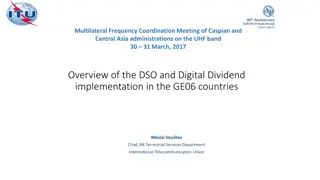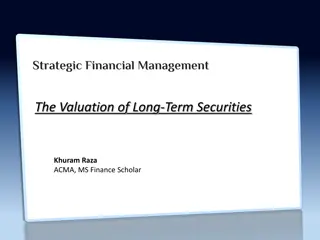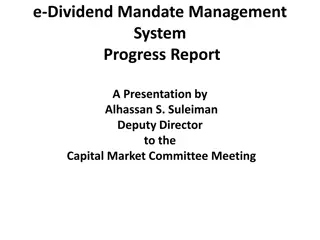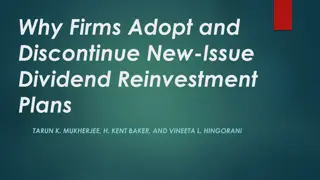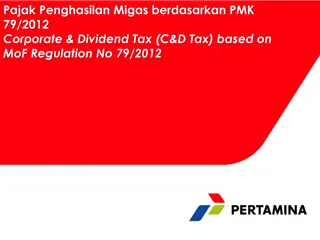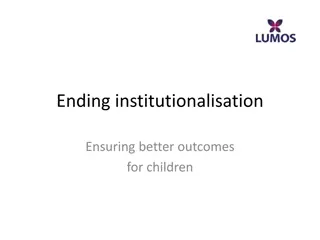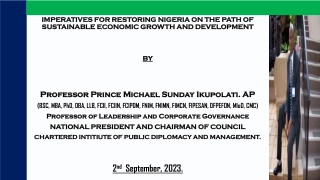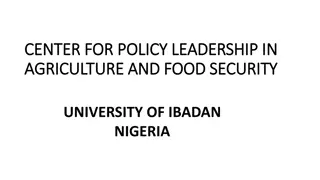Institutionalisation of Demographic Dividend Programming in Nigeria
Lessons from Nigeria highlight the importance of conscious efforts to achieve and sustain the demographic dividend (DD). Nigeria, a pre-dividend country, must focus on fertility decline, child health, and education for sustainable DD. Key stakeholders and programming steps for achieving DD are outlined, emphasizing integration with government planning and implementation strategies.
Download Presentation

Please find below an Image/Link to download the presentation.
The content on the website is provided AS IS for your information and personal use only. It may not be sold, licensed, or shared on other websites without obtaining consent from the author. Download presentation by click this link. If you encounter any issues during the download, it is possible that the publisher has removed the file from their server.
E N D
Presentation Transcript
Institutionalisation of the Demographic Dividend Programming: Lessons from Nigeria Olanrewaju Olaniyan, Akanni Lawanson, Noah Olasehinde, Oyeteju Odufuwa, Olabanji Awodumi, Osaretin Adonri and Andat Dasogot Presented at the 14th Global Meeting of the NTA Network with the theme Building Sustainable Generational Economies 15 Feb 2023
The demographic dividend cannot be achieved without conscious efforts Nigeria is a pre-dividend country given the level of fertility There can be no creation of the dividend if there is no fertility decline. There is no country that has been able to create DD without a fall in birth rates Even when the dividend is created there can be no harnessing of the DD if there is no improvement in child survival and maternal health Where efforts are made at harnessing the dividend, its sustainability cannot be assured without improvement in human capital especially child health and child education Creation and sustainability of the second DD rests on empowerment of the working age especially women (who are also within the child bearing age). 2
African Unions Agenda 2063: Four pillars in AU Roadmap on Demographic Dividend, 2017 3
Thematic Pillars in the Nigerian Demographic Dividend Roadmap, 2017
Key DD Stakeholders Governme nt (Federal, State and Local) Private Organisati ons Academia Ministries, Departme nts and Agencies NGOs, CBOs and CSOs Demograhic Dividend The Traditonal and Communit y Leaders (Baales...) Stakeholders Legislature , Executive and Judiciary Media (Print, Electronic and Social) Developm ent Partners Religious Leaders (Churches and Mosque Heads...)
Steps in the production of DD Sustaining the DD Harnessing the DD Cultivating the DD Creating the DD
7 Programming Steps for Achieving a DD Policy Framework Phase 4: Integration with the Government Planning Fundamentals Integration with the Development Plan Integration with the MTEF and annual budget Phase 1: Preparation To commit Country Profiles Gap Analysis Policy Declaration to Harness a DD Phase 2: Planning To be ready Building Partnerships Theory of Change Implementatio n Planning Phase 3: Implementation To get involved Programme implementation Monitoring and Evaluation Scaling Up Demographic Dividend Monitoring Index and Observatory Roadmap for Harnessing the Demographic Dividend Demographic Dividend Estimation and Profile Report Outputs
Steps to preparing the demographic dividend reports 8 Sensitisation on importance of population dynamics for sustainable economic A stakeholder analysis of the country s current demographic considerations Country modelling of the country s potential to benefit from a DD Drafting a document/report for national harnessing of a DD Official Policy analysis of Strategic Options pronouncement and validation of report
9 Main Outputs of the different stages of the programming Roadmap for Harnessing the Demographic Dividend Demographic Dividend Estimation and Profile Report Demographic Dividend Monitoring Index and Observatory Report
Programming the Demographic Dividend: The Journey so far 10
Four-Step activities in delivering the DD programming Achievement thus far through HPTRP/UNFPA Collaboration Sensitisation and Buy- in of Stakeholders Sensitisation of Different stakeholders on Demographic Dividend Five geopolitical zones (2014 2016) South West (2018) North Central (2019) South East States (2021) Gap analysis and Estimation of DD profiles Harmonisation of DD roadmap with Lagos State development plan and Budgeting guidelines (2017) Gap analysis and DD Profile Report for Nigeria (2018) Gap analysis, National Transfer Account (NTA) and DD Profile Report for Kaduna State (2019) Lagos State (2021) Monitoring &Evaluation and Setting up of Observatory National Demographic Dividend Monitoring Index Report (2020) Report on Institutionalisation and Setting up of an Observatory for Demographic Dividend, 2020 (National Report) Roadmap Preparation Roadmap for Harnessing the Demographic Dividend National Roadmap for Nigeria (2017) Lagos State (2018) FCT (2019) Kaduna (2019) Ogun State (2020) Ondo State (2020) Sokoto State
Domiciliation of Demographic Dividend Programming in the States of Nigeria Domiciliation Federal Capital Territory Nigeria Lagos Kaduna Ogun Ondo Sokoto Ministry of Economic Planning and Budget Ministry of Economic Planning and Budget Ministry of Budget, Planning and Statistics Ministry of Economic Planning and Budget Ministry of Budget and Economic Planning Economic Planning, Research and Statistics Department Ministry of Finance, Budget and National Planning
The Structure of the National Observatory for the DD Three main Committees Steering Committee Implementation Committee Monitoring Committee 13
The Structure of the National Observatory Steering Committee Implementation Committee Monitoring Committee Pillar 2: Education and Skill Development Pillar 3: Pillar 4: Pillar 1: Health and Wellbeing Pillar 5: DD Evidence Building Employment and Entrepreneurship Governance and Youth Participation 14
Functions of the different Committees Steering Committee Implementation Committee Monitoring Committee 1. Develop the detailed implementation plan containing detailed activities, timeline for delivery, and financing strategy 2. Meets quarterly to review progress of the planned activities 3. Engaging strategic development partners and donors 4. DD Communication and advocacy 5. Data Collection, modelling and analysis 5. Reports to the Steering Committee 1. Monitor the signature indicators for tracking progress in the implementation of the DD activities 2. Coordinate and report on progress in the implementation of the DD activities using timeline targets set by Implementation Committee 3. Reports to the Steering Committee 1. Provide overall coordination of DD activities 2. Meets biannually to review implementation status and re-strategise on the advice of the technical committees 3. Signal policy direction for all MDAs involved in the process 15
Membership of the different Committees IMPLEMENTATION COMMITTEE Director General, National Population Commission Chair STEERING COMMITTEE MONITORING COMMITTEE Permanent Secretary, Budget and National Planning Chair National Bureau of Statistics Monitoring & Evaluation Officers of direct DD-related MDAs (Nat. Pop Com., Health, Education, Labour and Employment, Justice, Youth and Sport, Agriculture and Rural Development, Women Affairs and Social Development, Information and Culture; Communication; Trade and Investments) SGF Chair Minister, Budget and National Planning Chairman, National Population Commission Minister of direct DD-related MDAs (Health, Education, Labour and Employment, Justice, Youth and Sport, Agriculture and Rural Development, Women Affairs and Social Development, Information and Culture; Communication; Trade and Investments) Senior Special Assistant to the President on SDGs Statistician-General Representative of Devt. Partners &CSOs Desk Officers of direct DD-related MDAs (Budget and National Planning, Health, Education, Labour and Employment, Justice, Youth and Sport, Agriculture and Rural Development, Women Affairs and Social Development, Information and Culture; Communication; Trade and Investments) 16
The Structure of the National Observatory: Domiciliation Office of Secretary to the Government of the Federation (SGF) Ministry of Budget and Planning National Population Commission National Dashboard Ministry of Health Ministry of Education Ministry of Budget and Planning Ministry of Women Affairs Ministry of Youth Ministry of Information and Culture Sectoral Dashboards 17
Lessons Learnt from the DD Programming Knowledge of the Demographic Dividend, although growing is still limited Inclusive and carefully planned and delivered sensitization and advocacy programme on DD can kindle enormous public interest, and have a great potential to stimulate action and commitment to DD as a strategy of harnessing the potentials of young people for sustainable development. The potential for harnessing demographic dividend in Nigeria will be directly linked to a decline in birth rates that shifts the population s age structure away from a pattern dominated by large numbers of dependent children. 18
Lessons Learnt from the DD Programming The speed of fertility decline is key. Lower fertility, can increase the resources available to save and invest, both in physical capital and in the health and education and children Fertility decline is necessary in creating DD, other policies are just for harnessing the DD after it has been created. The slow pace of creating DD rests on the slow pace of fertility decline in the country 19
Lessons Learnt from the DD programming in Nigeria Data Issues are still prevalent Geographic disparities and diversities in Nigeria is important to the creation and reaping of demographic dividends Gap in population projection estimates by different States of the country While nationally representative data are generally available and reliable, States and regional data for estimating the profiles are largely unavailable making it necessary for rapid surveys in order to get the profiles Demographic Dividend is Multisectoral and multidisciplinary in content and understanding To fully reap demographic dividend, institutions, policy makers and academics must work out of silos and collaborate so that they exploit their various strengths 20
Lessons Learnt from the DD programming The quality and magnitude of the Support ratio is key to harnessing the demographic dividend Stakeholder engagement is key Buy in of the relevant government stakeholders in the National Transfer Accounts estimation and results Process of Dissemination handled by the stakeholders for more acceptability within the country Interagency rivalry should be discussed and prevented Buy-in for the institutionalisation of the Demographic dividend estimation, monitoring, and process of reaping the benefits 21
Thank you for your attention Health Policy Training And Research Programme (HPTRP) University of Ibadan, Nigeria 22
